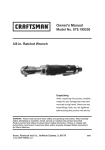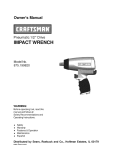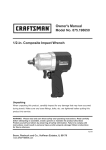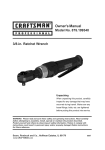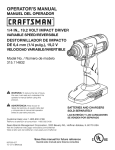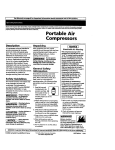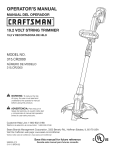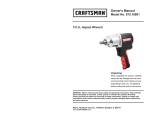Download Craftsman 875.199800 Owner`s manual
Transcript
Owner's Manual Model No. 875.199800 3/8-in. Butterfly impact Wrench Unpacking When unpacking inspect occurred loose before this for any damage during fittings, putting transit. bolts, this product, carefully that may have Make sure any etc. are tightened product into service. WARNING: Please read and save these safety and operating instructions. Read carefully before attempting to assemble, install, operate or maintain the product described. Protect yourself and others by observing all safety information. Failure to comply with instructions could result in personal injury and/or property damage! Retain instructions for future reference. Sears, Roebuck and www.CRAFTSMAN.com Co., Hoffman Estates, IL 60179 o807 Owner's Manual Model No. 875.199800 Owner's Manual Model No. 875.199800 90 PSI Maximum This tool is designed to operate at an air _, Features ONE YEAR FULL WARRANTY & Benefits ON _, Specifications _, Product Warranty CRAFTSMAN _, Compressor Requirements If this Craftsman tool fails to give complete Safety Instructions satisfaction within one year from the date Important _, Installation and Operation _, Maintenance of purchase, TOOL RETURN IT TO ANY SEARS STORE OR OTHER CRAFTSMAN _, Exploded View Drawing & Parts List _, Troubleshooting OUTLET IN THE UNITED STATES FOR FREE REPLACEMENT. If this Craftsman Read Operating gauge pressure (90 PSI) maximum, instructions tool. Use of higher air pressure can, and and warnings before at the may cause injury. Also, the use of higher operating any pneumatic tool. air pressure places the internal Always Wear Approved Eye Protection Impact resistant eye protection Educational components under loads and stresses they were not designed for, causing should meet or exceed the standards ANSI Z87.1, Occupational tool is ever used for pressure of 90 pounds per square inch Instructions Please become familiar with all the set forth in premature tool failure. California Prop 65 and Eye and Face Protection. Look for marking Z87.1 on your eye commercial The Craftsman Square Drive Model 875.199800 Butterfly Impact Wrench is ideal for general assembly, agricultural 3/8" automotive, date of purchase. This warranty does not parts, such as lamps, batteries, bits or blades. This warranty Features a built-in regulator for power for increased this applies for only 90 days from the include expendable and industrial applications. output adjustment; warranty or rental purposes, gives you specific legal rights, and you jumbo hammer clutch power output; and a ring- may also have other rights which vary from state to state. type socket retainer allows quick socket changes. Sears, Roebuck and Co., Hoffrnan Estates, IL60179 protection to ensure that it is an approved style. Hearing Some dust created by power Protection Hearing protection is Recommended should be used when the noise level exposure exceeds an 8 hour time-weighted sound level of 85dBA. average Some examples to cause cancer, reproductive nearby, all add to the noise level determine your noise level exposure, of these chemicals we masonry chromium lumber. products, arsenic and the use of hearing protection. 3/8" Impacts per minute ..................... 850 IPM Free speed (No Load) ......... 10,000 RPM Ultimate torque .......................... 95 ft. Ibs. Weight .............................................. 2 Ibs. Overall length .................................. 7.25" Average air consumption ........ 3.6 SCFM Recommended hose size .......... 3/8" I.D. Air inlet ....................................... 1/4" NPT Maximum Air Pressure .................. 90 PSI Light Use - 12 Gallon Avoid Prolonged Heavy Use - 33 Gallon Professional Prolonged exposure repetitive to Vibration to vibration or very hand and arm movements cause injury. Discontinue tool if you experience discomfort can the use of any tingling, numbness, depending varies, on how often you do this type of work. To reduce your exposure to these chemicals: work in a well ventilated area, and work with approved safety equipment, such as dust masks that are specifically out microscopic designed to filter particles. or pain in your hands or arms. You should consult your physician before resuming ENG-2 Exposure Pneumatic tools can vibrate during use. Typical Use - 17 Gallon are: from chemicafty-treated Your risk from those exposures Drive size ........................................... birth harm. Lead from lead based paint, crystalline silica from bricks and cement and other in a given work area. If you are unable to recommend known or other Process noise, reflective surfaces, other tools being operated chemicals defects equals or sanding, sawing, grinding, drifting and other construction activities contains use of tool. ENG-3 Owner's Manual Disconnect Model No. 875.199800 the air tool from air supply and during non-operation. Do not wear loose fitting clothing, Manual Some materials before changing tools or attachments, servicing Owner's tar, contain Use attachments designed for use with air powered tool. Always examine could accessories prolonged before mounting for chips, such as adhesives chemicals cause serious Model whose injury exposure. and vapors with Always No. 875.199800 work in a Tools which cut, shear, drill, staple, punch, chisel, etc. are capable of scarves, or neck ties in work area. Loose cracks, causing serious clothing may become caught in moving Never use mounted points or other working part of the tool away from parts and result in serious personal accessories that have been dropped or exposed to water, solvent or extreme hands and body. Do not wear jewelry when injury. operating any tool. Jewelry may become caught in temperature clean, dry, well ventilated of damage. enclosure for one minute after mounting injury. Do not depress trigger when connecting area. any accessory. Tools which contain moving or drive other grinding moving wheels, elements, tools, such sockets, sanding discs, Never trigger hair, clothing, jewelry and other loose objects, resulting in severe injury. the tool when not applied Attachments attached. Always rating must be securely Loose attachments can cause use accessories with an RPM that meets or exceeds the tool RPM rating. which Never point an air tool at oneself other person. Serious injury could occur. Never carry a tool by the hose or pull the hose to move the tool or a Check compressor. or any for weak or worn conditions before each use. Make sure all connections are secure. loose straps Keep hoses heat, oil and sharp before as grinders, to install, service, or perform any maintenance. generate which and screws tight and ensure equipment is in safe working condition. might become parts. through the exhaust oil port during the first few seconds of operation. Thus, the exhaust port must be covered with a towel before applying air pressure. which caught UseO_ _ by the Seda_ & A=,=essedas Only use sockets designated "FOR USE WITH IMPACT WRENCHES." Hand tool Tie up or cover long hair. sockets can break, creating weak or worn. hazard: Abrasive sanders tools, such and cut-off tools dust and abrasive can be harmful materials to human a hazard from flying pieces. Always check sockets, retainers and drives regularly any maintained tools and can cause serious injury. and replace when necessary. the tool with care. A properly maintained tool, with sharp cutting edges, reduces the risk of binding is easier to control. and lungs and respiratory system. MSHA/NIOSH approved, Always wear properly fitting damaged. There is a risk of bursting face mask or respirator such tools. when using binding if the tool is Check for misallgnment of moving parts, breakage or of parts and any other condition that affects the tool's operation. If damaged, have the tool serviced ENG-4 an air tool has been lubricated, will discharge or ties, that could Keep hands away from moving Maintain Inhalation Keep all nuts, bolts After for wear or damage Release all pressure from the system relocate in away from edges. Replace hose that is damaged, tool. Improperly accessories attempting Keep the become tangled in moving parts of the tool. Remove any jewelry, watches, etc., or puncture. air hoses entangled Never wear loose fitting apparel contains serious injury. Protect air lines from damage etc., can become as the air supply hose. to a work object. injury. changes, it is a good practice to operate the tool in a protected moving parts and result in serious personal or signs before using. ENG-5 Owner's Manual Model No. 875.199800 Owner's Manual be a flexible Air Tool Hook Up movement Model No. 875.199800 hose in order to isolate of the compressor. This tool features a regulator valve. Rotate Route the initial take-off line (pipe) as regulator straight The setting (H) and (L) on the regulator up the shop wall and as high as possible. This will help minimize water leaving the compressor traveling and through system until desired output is achieved. are only for reference and do not denote a specific power output. Turn regulator to position with (L) being the least amount of power and (H) being for the most amount Slope the main lines down at least of power. (See Figure 2) 3/4 inch per 10 feet of pipe away from air compressor; the condensate this will draw with the flow of air and away from the compressor. Place the first drop as far from the compressor Before the tool is connected to the air supply, clear the air hose of accumulated dust and moisture although Never carry a tool by the hose or pull the unrealistic The hose to move the tool or a compressor. further the drop, the more that Keep hoses away from heat, oil and sharp condensation edges. Replace any hose that is damaged, drier the air will be when it reaches weak or worn. the water separator. by running air freely through the air hose for 5-10 seconds. Small (home) shop hard piping: air is shown. Some helpful tips are: Always use hoses and pipes rated for A 3/8 inch ID air hose is required up to a higher pressure length of 25 feet. A 3/8 inch ID hose encounter. than your system will longer than 25 feet will cause a pressure If more length is required, a ½ inch ID air hose is recommended. Be sure all hoses and fittings are the correct size and correctly secured before using the tool. Never use PVC pipes for compressed explosion air piping systems and serious as injury may result. The connection the water separator, Figure 2 Regulator Valve that get into install the take- off line on the top of the main air hose hook up. drop and may impede performance. can occur, and the water and contaminants A piping diagram for a typical home shop 1 Illustrates a recommended for a small shop). In order to reduce the amount of Air Hoses for your Air Tools Figure as the size of your shop will allow (50 feet is optimal, supply line for each air drop. Once a bolt or fastener A Drain line should be placed at the is seated, end of the main line for condensate impacting for longer than five (5) seconds will cause excessive wear and drainage. possible damage to the impacting Drain valves should be placed at the mechanism. If it takes longer than five seconds to tighten or loosen your bolt end of branch lines and the drain or fastener, line, and drained daily. larger size impact we recommend the use of a wrench. from the compressor to the initial take-off hard pipe must ENG-6 ENG-7 Owner's Manual Model No. 875.199800 1. Disconnect the impact wrench from the air supply. An in-line filter-regulator-lubricator (fig 1) is recommended as it increases tool life and keeps the tool in sustained operation. The in-line lubricator should be regularly checked and filled with air tool oil. Proper adjustment of the in-line lubricator is performed by placing a sheet of paper next to the tools exhaust ports and holding the throttle open approximately 30 seconds. The lubricator is properly set when a light stain of oil collects on the paper. Excessive amounts of oil should be avoided. In the event that it becomes necessary to store the tool for an extended period of time (overnight, weekend, etc.), it should receive a generous amount of lubrication through the air inlet (Figure 3). The tool should be run for approximately 30 seconds to ensure oil has been evenly distributed throughout the tool. The tool should be stored in a clean and dry environment. (Refer to figure Model No. 875.199800 View Drawing 3). 3. Squeeze approximately 1 oz. of 30 weight oil through the oil port hole. Replace the screw. 4. Reconnect the air supply to the impact wrench and run for 20 to 30 seconds. Lubricate the entire impact mechanism by rotating the tool upside down and sideways while running the tool. 5. Remove the screw and hold the oil port hole over a suitable container to allow excess oil to drain. Sometimes triggering the tool when dumping the oils helps to force out the excess oil. 6. If the oil is dirty, repeat the procedureabove until the oil comes out clear. Install the screw and tighten. The residual oil remaining in the impact mechanism chamber is all that is needed for proper Parts List Ref. Part# 1 9106257 2 9106258 3 9106259 4 9150070 Lubricants IMPACT MECHANISM 44 lubrication. Use air tool oil or any other high grade turbine oil containing moisture absorbent, rust inhibitors, metal wetting agents and an EP (extreme pressure) additive. See Figure 3 for location/air inlet. LUBRICATION The impact mechanism transfers power from the tool to a nut or bolt. Oil in the mechanism is forced out and must be replaced. Lubricate the impact mechanism one time a year; more often if a tool is used more than ten hours a week. Lubricate air motor here To lubricate and clean the impact mechanism and the front bearing: Figure ENG-8 Exploded Manual 2. Remove the slotted screw or Allen head screw from the oil port hole (Ref. #41) Lubrication Recommended Owner's 5 6 7 8 9 9106261 9106262 9106263 9106264 9106265 10 11 12 13 14 9106266 9106267 9106268 956313 956314 15 16 17 18 19 9106269 9106270 9106271 9106272 9106273 20 21 22 9106274 9106275 9106276 Description Housing Anvil Bushing Socket Retainer O-Ring Anvil Hammer Hammer Hammer Washer Cage Dog Pin Qty. 1 1 1 1 1 1 1 2 1 Ref. 23 24 25 26 27 Part# 9106277 9106278 9106279 9106280 9106281 Description O-Ring Valve Seat Valve Spring Screw Reverse Switch Qty. 2 2 2 1 1 28 29 9106282 9106283 O-Ring Air Regulator 1 1 30 31 32 9106284 9106285 9106286 O-Ring Valve Sleeve Pin 1 1 1 33 34 9106287 9106288 O-Ring O-Ring 2 1 35 36 37 9106289 9106290 9106291 Spring Steel Ball Air Inlet Block 1 1 1 9106292 9106293 9106294 9106295 9106296 Cap Screw Protective Nose Cover Seal Screw Throttle Lever Pin 4 1 1 1 2 9106297 9106298 Throttle Washer 1 1 Ball Bearing Front End Plate 1 1 Plug Cylinder Rotor 2 1 1 Dowel Pin Rotor Blade Rear End Plate 1 6 1 Ball Bearing Ornamental Gasket 1 1 Gasket 1 38 39 40 41 42 End Cap Valve Stem 1 2 43 44 Lever 3 ENG-9 Owner's Tool runs slow or will Manual 1. Grit or gum in tool not operate. Model No. 875.199800 1. Flush the tool with air tool oil, gum solvent, or an equal mixture of SAE 10 motor oil and kerosene. Lubricate the tool after cleaning. 2. No oil in tool 2. Lubricate the tool according to the lubrication instructions in this manual. 3. Low air pressure 3a. Adjust the regulator on the tool to the maximum setting (If applicable). 3b. Adjust the compressor regulator to tool maximum while the tool is running free 4. Air hose leaks 4. Tighten and seal hose fittings if leaks are found. Owner's Manual Impacts slowly or will not impact 2. Tool regulator set in wrong position 3. In-line regulator or compressor regulator set too low Impacts rapidly but 1. Worn impact will not remove bolts mechanism Does not impact 5. Pressure drops 5a. Be sure the hose is the proper size. Long hoses or tools using large volumes of air may require a hose with an I.D. of 1/2" or larger depending on the total length of the hose. 1. Lack of lubrication 1. Broken impact mechanism Model No. 875.199800 1. Lubricate the air motor and the impact mechanism. (See Lubrication section of this manual) 2. Adjust the regulator on the tool to the maximum setting 3. Adjust regulators in the air system 1. Replace worn impact mechanism components 1. Replace broken impact mechanism components Notes: 5b. Do not use multiple number of hoses connected together with quick connect fittings. This causes additional pressure drops and reduces the tool power. Directly connect the hoses together. Moisture blowing out of tool 1. Water in tank 1. Drain tank. (See air compressor manual). Oil tool and run until no water is evident. Oil tool again and run 1-2 seconds 2. Water in the air lines/ hoses 2a. Install a water separator/filter. NOTE: Separators only work properly when the air passing through the separator is cool. Locate the separator/filter as far as possible from the compressor. 2b. Install an air dryer. 2c. Anytime water enters the tool, the tool should be oiled immediately. ENG-10 ENG-11 Manual dei Propietario Modelo No. 875.199800 Llave de impacto de mariposa de 3/8 puig Desempaquetar Despues examinelo identificar ocurrido de desempaquetar cuidadosamente el producto, para da_os que pudieron durante el transporte. Cerci6rese de apretar accesorio, perno, este producto haber cualquier etc., antes de poner en servicio. ADVERTENCIA: Lea y guarde estas instrucciones de seguridad y operaci6n. Lea detalladamente antes de tratar de ensamblar, instalar, operar o mantener el producto descrito. Prot_jase usted y protega a los demos respetando toda la informaci6n de seguridad. El incumplimiento con estas instrucciones podria resultar en una lesi6n personal, un da_o de la propiedad o ambos. Conserve las instrucciones como referencia futura. Sears, Roebuck www.CRAFTSMAN.com and Co., Hoffman Estates, IL 60179 0807 Manual del Propietario Modelo Caracteristicas y operaci6n Especificaciones Garantia del producto Requisitos del compresor Instrucciones de seguridad importantes Instalaci6n y operaci6n Mantenimiento Piano de vista despiezada y lista de piezas Localizaci6n y soluci6n de fallas La Ilave de impacto de mariposa con mando cuadrado de 3/8 pulg Craftsman, Modelo 875.199800, es ideal para usar en el ensamble general, asi como en aplicaciones de autom6viles, agricultura e industriales. Consta de un regulador integrado para el ajuste de la salida de potencia; embrague de martillo gemelo para mayor salida de potencia; y retenedor de casquilio tipo anillo que permite cambios rapidos de los casquilios. TamaSo del accionador ............................... Impactos por minuto .......................... GARANTiA COMPLETA POR UN ANO DE HERRAMIENTA CRAFTSMAN Siesta herramienta Craftsman falIa en proporcionarte una satisfacci6n compteta dentro de un aSo a partir de su fecha de compra, DEVU €:LVALAA CUALQUIER TIENDA SEARS U OTROS ESTABLEClMIENTOS DE SEARS EN LOS ESTADOS UNIDOS, PARA UN REEMPLAZO GRATIS. Siesta herramienta Craftsman alguna vez se usa para fines comerciales o de aiquiIer, esta garantia se apiica soIamente por 90 dias a partir de Ia fecha de compra. Esta garantia no incIuye Ias piezas consumibtes, como Iamparas, baterias, brocas u hojas. Esta garantia Ie proporciona derechos Iegales especificos, y usted puede tener tambien otros derechos que varian de estado a estado. Sears, Roebuck and Co., Hoffman Estates, IL 60179 3/8" 850 i.p.m. Velocidad libre (sin carga) .............. 10,000 RPM Par torsor final .......................... 95 pies por libra Peso ....................................................... 2 libras Longitud total ............................................. 7.25" Consumo promedio de aire ............... 3.6 SCFM TamaSo recomendado para la manguera .............. Di& int. de 3!8 pulg Admisi6n de aire .......................... 1/4 pulg NPT Presi6n de aire maxima .......................... 90 PSI SPA-2 No. 875.199800 Poco uso - 12 galones Uso regular - 17 galones Uso pesado - 33 galones profesional Manual del Propietario Lea las instrucciones de operacion FamiIiaricese con todas Ias instrucciones y advertencias antes de usar cuaiquiera herramienta neumatica. Use siempre proteccion adecuada para los ojos La protecci6n ocular resistente aI impacto debera satisfacer o superar Ias normas especificadas en ANSI Z87.1, bajo el tituIo Protecci6n ocular y facial ocupacional y educativa. Busque Ia marca Z87.1 en su protector de los ojos para asegurar que es un estiIo aprobado. Se recomienda proteccion de los oidos La protecci6n de los oidos debe usarse cuando Ia exposici6n de niveI de sonido iguala o excede un niveI promedio ponderado por tiempo, de 8 horas, de 85dBA. El ruido deI proceso, superficies reflectoras, otras herramientas operadas en Ia cercania, todos agregan aI niveI de ruido en un area determinada de trabajo. Si no es posibte determinar Ia exposici6n al nivel de ruido, se recomienda usar protecci6n auditiva. Evite la exposicion prolongada a la vibracion. Las herramientas neumaticas pueden vibrar durante su uso. La exposici6n prolongada a Ias vibraciones o los movimientos muy repetidos de manos y brazos pueden causar Iesiones. Interrumpa el uso de cuaIquier herramienta si experimenta cosquiIIeo, adormecimiento, maIestar o dolor en Ias manos o brazos. Debera consuItar con su medico antes de seguir usando Ia herramienta. Modelo No. 875.199800 90 PSIG MAXIMO Esta herramienta esta diseSada para operar a una presi6n neumatica maxima de indicador de 90 Iibras por pulgada cuadrada (90 PSI), en Ia herramienta. El uso de una presi6n de aire mayor puede y podra causar Iesiones. Tambien, el uso de una presi6n neumatica mayor somete a los componentes internos a cargas y tensiones para Ias cuales no fueron diseSados, causando una falla prematura de Ia herramienta. Proyecto de ley 65 de California Algunos polvos creados por el fijado, aserrado, desgastado, taladrado y otras actividades de construcci6n contienen substancias quimicas conocidas come causantes de cancer, defectos de nacimiento u otras lesiones en el sistema de reproducci6n. Algunos ejemplos de esas sustancias quimicas son_ Plomo de pinturas que contienen plomo silice cristalino de ladrillos, cemento y otros productos de alba#ileria ars@nico y cromo de madera quimicamente tratada Su riesgo de esas exposiciones varia, dependiendo de cuan a menudo usted electra este tipo de trabajo. Para reducir su exposici6n a estos materiales: trabaje en un area bien ventilada y con los equipos de protecci6n aprobados, como mascaras de polvo que esten especificamente dise#adas para filtrar particulas microsc6picas. SPA-3 Manual del Propietario Desconecte la herramienta del suministro de aire antes de cambiar herramientas o accesorios, darte servicio o durante el tiempo que no este funcionando. No use ropa suelta, bufandas o corbatas en el area de trabajo. La ropa sueIta podria quedar atrapada en las piezas en movimiento y resultar en una Iesi6n personal grave. No use joyas mientras usa la herramienta. Las joyas podrian quedar atrapadas en Ias piezas en movimiento y resultar en una Iesi6n personal grave. No presione el disparador cuando este conectando Ia manguera de suministro de aire. No apriete el disparador de la herramienta cuando no se aptique a un objeto de trabajo. Los accesorios deben acoplarse de forma segura. Los accesorios sueltos pueden causar una Iesi6n grave. Protega las lineas de aire contra los daSos y punciones. Nunca apunte una herramienta neumatica a sus propia persona ni a ninguna otra persona. Podria ocumr una Iesi6n grave. Revise las mangueras de aire en busca de condiciones debiles o de desgaste antes de cada uso. AsegQrese de que todas Ias conexiones esten bien afianzadas. Libere toda la presion del sistema antes de tratar de instalar, dar servicio, reubicar o realizar cualquier mantenimiento. Mantenga todas las tuercas, pernos y tornillos apretados, y asegure que el equipo este en condiciones de trabajo seguras. SPA-4 Modelo No. 875.199800 Use accesorios dise#ados para utilizar con la herramienta electrica neumatica. Siempre examine los accesorios antes del montaje en busca de astillas, grietas o indicios de alg_n da#o. Nunca use puntos montados u otros accesodos que se han caido o se han expuesto al agua, disolventes o cambios extremos de temperatura. Es bueno usar la herramienta en un alojamiento protegido por un minuto despues de montarle cualquier accesorio. Siempre use accesorios clasificados para revoluciones pot minutos (RPM) que cumplan o excedan con la clasificaci6n de RPM de la herramienta. Nunca fleve una herramienta pot la manguera ni nunca tire de la manguera para mover una herramienta o un compresor. Mantenga las mangueras alejadas del calor, aceite y bordes afilados. Reemplace cualquier manguera que est# dahada, debil o desgastada. Peligro de inhalaci6n: Las herramientas abrasivas, como molinillos, lijadoras y herramientas de corte, generan polvo y materiales abrasivos que pueden ser da#inos para los pulmones y el sistema respiratorio de las personas. Siempre use una m#scara facial o respirador con buen ajuste, que este aprobado por MSHA/NIOSH, cuando utilice tales herramientas. Manual del Propietario Algunos materiales, como adhesivos y alquitran, continen compuestos quimicos cuyos vapores podrian causar una grave lesi6n con la exposici6n prolongada. Trabaje siempre en un area limpia, seca y bien ventilada. Las herramientas que contienen piezas m6vfles, o que impulsan a otras herramientas m6viles, como ruedas amoladoras, cubos, discos lijadores, etc., pueden enredarse en el pelo, ropa, joya y otros objetos sueltos, resultando en una grave lesi6n. Nunca use ropa suelta que contengan correas o corbatas, que podrian quedar atrapados en las piezas m6viles de la herramienta. Quitese cualquier joya, reloj, etc. que podria ser atrapado por la herramienta. Mangenga las manos alejadas de las piezas m6viles. Rec6jase o c_brase el pelo. Las herramientas y accesorios mal mantenidos pueden causar una lesi6n grave. D#le mantenimiento a la herramienta con cuidado. Estas herramientas de torte con el mantenimiento adecuado, con bordes de corte afilados, reducen el riesgo de atasco y son m#s f#ciles de controlar. Modelo No. 875.199800 Las herramientas que cortan, cizallan, barrenan, apilan, punzonan, cincelan, etc. pueden causar una lesi6n grave. Mantenga la pieza de trabajo de la herramienta alejada de las manos y el cuerpo. Despu#s de lubricar la herramienta neum#tica, el aceite ser# descargado por el puerto de escape durante los primeros segundos de operaci6n. Por Io tanto, el puerto de escape debe estar tapado con una toalla antes de aplicar presi6n de aire. Use solamente los casquillos y accesorios clasificados para impactos Use solamente aquellos casquillos que esten marcados como "PARA USAR CON LLAVES DE IMPACTO". Los casquillos para herramientas de mano pueden romperse y crear el riesgo de despedir proyectiles. Siempre verifique el estado de los casquillos, retenedores y elementos de accionamiento para detectar desgastes o averias. Reempl_celos cuando sea necesario. Si la herramienta esta da#ada existe el peligro de que explore repentinamente. Revise los desajustes o atascos de las piezas m6viles, roturas de las piezas y cualquier otra condici6na que afecte el funcionamiento de la herramienta. Si la misma esta da#ada, haga que se le de mantenimiento antes de usaHa. SPA-5 Manual del Propietario Cone×i6n Modelo de la manguera Linea principal = Dia. int. min. tnclinado hacia abajo y Linea Dia. Lubricador Regulador 1 = 1/2 pulg Linea de admision Filtro de drenaje Valvula de ! drenaje Valvula Manguera de aislamiento de drenaje Figura 1 Conexion de la manguera de aire correcto y que esten bien conectados antes de usar Ia herramienta neumatica. Antes de conectar Ia herramienta aI suministro de aire, Iimpie Ia manguera de aire para quitarte el poIvo y Ia humedad acumulados. Hagalo pasando aire Iibremente por Ia manguera por un tiempo de 5 a 10 segundos. Nunca IIeve una herramienta por Ia manguera ni nunca tire de Ia manguera para mover una herramienta o un compresor. Mantenga Ias mangueras alejadas deI calor, aceite y bordes afilados. Reemptace cuaIquier manguera que este daSada, debiI o desgastada. Mangueras de aire para sus herramientas neumaticas Tuberia para taller pequefio (para la casa): La Figura 1 ilustra Ia conexi6n recomendada de una manguera de aire. Se muestra un diagrama de tuberia para un taller tipico de una casa. Atgunos consejos 0tiles son: Se requiere una manguera neumatica de un diametro interior de 3/8 pulg hasta un largo de 25 pies. Una manguera con un diametro interior de 3/8 puIg mas Iarga de 25 pies causara una caida de presi6n, Io que podria impedir el rendimiento. Si se requiere un mayor Iongitud, se recomienda usar una manguera de aire de un diametro interior de 1/2 puIg. Aseg0rese de que todas Ias mangueras y accesorios sean deI tamaSo SPA-6 Encamine Ia tuberia de admisi6n iniciaI recta hacia hacia arriba por Ia pared deI taller y Io mas alto posibte. Esto ayudara a minimizar que el agua que sale deI compresor viaje por el sistema. VaIvula de cierre Linea Manual del Propietario La conexi6n desde el compresor a Ia tuberia rigida de admisi6n inicial debe ser a traves de una manguera flexible para aisIar el movimiento deI compresor. de aire 1/2 pulg bifurcaci6n int. No. 875.199800 Siempre use mangueras y tuberias que esten clasificadas para una presi6n mayor que Ia que su sistema necesitara. Nunca use tuberias de PVC para sistemas de tuberia de aire comprimido porque pueden resuItar en una exptosici6n o una Iesi6n grave. Modelo No. 875.199800 La herramienta tiene una valvula reguladora. Gire el regulador hasta que Iogre Ia salida deseada. Los valores fijados (H) y (L) en el regulador son s6Io como referencia y no denotan una salidad de potencia especifica. Gire el reguIador a una posici6n donde (L) sea Ia cantidad de potencia menor y (H) sea Ia cantidad de potencia mayor. (Vea Ia Figura 2). Incline hacia abajo Ias Iineas principales por Io menos 3/4 de puIg por cada 10 pies de tuberia alejandose deI compresor de aire. Esto extraera Ia condensaci6n con el ftujo de aire que sale deI compresor. H Coloque el primer bajante Io mas Iejos posibte deI compresor que el tamaSo de su taller permita (50 pies es Io 6ptimo, aunque poco realista para un taller pequeSo). Entre mas alejado este el bajante, mayor condensaci6n puede ocurrir, y mas seco sera el aire cuando alcance el separador de agua. Para reducir Ia cantidad de agua y contaminantes que entran al separador de agua, instale Ia Iinea de admisi6n arriba de Ia Iinea principal de suministro de aire para cada bajante de aire. Se debe colocar una Iinea de drenaje al final de Ia Iinea principal para evacuar Ia condensaci6n. Las valvulas de drenaje deben colocarse aI final de Ias Iineas de ramificaci6n y Ia Iinea de drenaje, y se deben evacuar diariamente. FJgura 2 VaJvuJa del reguJador ADVERTENCIAJ Una vez asentado un perno o sujetador, la acci6n de impactar per mas de cinco (5) segundos producira desgaste en exceso y posibles da_os a! mecanismo de impactaci6n Si tarda mas de cinco segundos para ajustar o aflojar su perno o sujetador, recomendamos el uso de una Ilave de impacto de tamaho mayor. SPA-7 Manual del Propietario Modelo 1. No. 875.199800 Desconecte la Ilave de impacto del suministro de aire. Manual del Propietario Piano Modelo No. 875.199800 de vista despiezada 7 2. Quite el tornillo ranurado o de cabezal Allen Lubricacibn Se recomienda usar un filtro-reguladorlubricador en linea (Fig.l) ya que incrementa la duraci6n de la herramienta y mantiene la herramienta en una operaci6n sostenida. Debera comprobar el lubricador en linea con regularidad y Ilenarlo con aceite para 4. Reconecte el suministro aproximadamente. Se ajusta Deberan evitarse las cantidades excesivas de aceite. En caso de ser necesario almacenar la herramienta durante un largo tiempo (de la noche a la mafiana, un fin de semana, etc.), debera lubricarla abundantemente a traves de la entrada de aire (Fig. 3). Debera operar la herramienta durante 30 segundos aproximadamente para asegurar la distribuci6n pareja del aceite en toda la herramienta. Debera almacenarse la herramienta en un medio limpio y seco. Lubricantes Use un aceite de herramienta cualquier otro aceite turbina que contenga inhibidores de 6xido, del metal y un aditivo Vea la Fig. 3 para la aire. LUBRICACION IMPACTACION El mecanismo 5. Quite el tornillo y sostenga el orificio del puerto del aceite sobre un recipiente adecuado para dejar que el exceso de aceite drene. A veces apretar el disparador de la herramienta mientras se deshace del neumatica u 6. de impactaci6n impactacion por aqui transfiere potencia desde la herramienta a una tuerca o perno. El aceite del mecanismo es forzado a que salga y debe ser reemplazado. Lubrique el mecanismo de impactaci6n una vez al afio; con mas frecuencia si la herramienta se usa mas de diez horas a la semana. SPA-8 / / 2O 23 24 5;' Lista de piezas el mecanismo de DE Para lubricar y limpiar el mecanismo de impactaci6n y el cojinete frontal: 22 Si el aceite esta sucio, repita el procedimiento indicado arriba hasta que el aceite salga limpio. Coloque el tornillo y aprietelo. El aceite residual que queda en la camara del mecanismo de impactaci6n es todo Io que se necesita para la buena lubricaci6n. de grado elevado de absorbente de humedad, agentes humidificadores EP (presi6n extrema). ubicaci6n y entrada de DEL MECANISMO 22 aceite ayuda a la salida forzada del exceso de aceite. Lubrique recomendados de aire a la Ilave de impacto y deje funcionar de 20 a 30 segundos. Lubrique todo el mecanismo de impactaci6n girando la herramienta hacia abajo y hacia los laterales mientras que funciona. una hoja de papel pr6xima a los correctamente el lubricador cuando el papel queda manchado con una ligera mancha de aceite. / Eche aproximadamente 1 onza de aceite peso 30 por el orificio del puerte de aceite. Vuelva a colocar el tornillo. orificios de escape de la herramienta y manteniendo abierto el acelerador durante 30 segundos 4 del orificio del puerto de aceite (ref. #41 ) (Consulte la Figura 3 ). herramientas de aire comprimido. El ajuste correcto del lubricador en linea se realiza colocando ,," Lubrique el motor neumatico por aqui Ref. Pieza # 1 9106257 2 9106258 3 9106259 4 5 6 9150070 9106261 9106262 Descripcion Cerramiento Cojinete del yunque Retenedor de casquillo adaptador Junta t6rica Yunque Caja del martitto 7 8 9 10 11 12 13 14 15 16 17 18 19 20 21 22 23 9106263 9106264 9106265 9106266 9106267 9106268 956313 956314 9106269 9106270 9106271 9106272 9106273 9106274 9106275 9106276 9106277 Garra de martillo Clavija del martillo Arandela Rodamiento esferico Ptaca delantera Tap6n Cilindro Rotor Clavija Paleta del rotor Ptaca posterior Rodamiento esferico Junta de adorno Junta Cubierta de extremo Vastago de vatvula Junta t6rica Ctd. 1 1 1 2 1 1 1 2 1 1 1 6 1 1 1 1 1 2 2 1 1 1 1 Ref, 24 25 26 27 28 29 30 31 32 33 34 35 36 37 Pieza # 9106278 9106279 9106280 9106281 9106282 9106283 9106284 9106285 9106286 9106287 9106288 9106289 9106290 9106291 38 39 9106292 9106293 40 41 42 9106294 9106295 9106296 43 44 9106297 9106298 Descripcion Asiento de la valvuia Resorte de la v_lvula Tornillo Interruptor de reversa Junta t6rica Regulador de aire Junta t6rica Manguito de la vatvula Clavija Junta t6rica Junta t6rica Resorte Esfera de acero Bloque de entrada de aire Tap6n del tornillo Cubierta de nariz de protecci6n Junta estanca Tornillo Clavija de palanca del acelerador Patanca del acelerador Arandela Ctd, 2 2 1 1 1 1 1 1 1 2 1 1 1 1 4 1 1 1 2 1 1 Figura 3 SPA-9 Manual del Propietario La herramienta funciona lentamente o no funciona. Modelo 1. Irrigue la herramienta con aceite para herramientas neumaticas, diluyente de resinas, o una mezcla de igual proproci6n de aceite de motor SAE 10 y queroseno. Lubrique la herramienta despues de la limpieza. 1. En la herramienta hay polvo, arena o resina. 2. En la herramienta aceite, no hay 3. La presi6n del aire esta baja. 4. Fugas de la manguera aire 5. Caidas de presi6n. No. 875.199800 Impactos lentos o no Modelo a su valor 1. Lubrique el motor del aire y el mecanismo de impactaci6n. (Consulte la secci6n Lubricaci6n de este manual). 2. El regulador de la herramienta esta puesto en la posici6n incorrecta, 2. Ajuste el regulador de la herramienta a su valor maximo, 3. Regulador en linea o regulador del compresor fijado muy bajo 3. Ajuste los reguladores 1. Reemplace los componentes desgastados del mecanismo de impactaci6n. 3b. Ajuste el regulador del compresor al maximo de la herramienta mientras que la herramienta funciona libre. Proyecta impactos rapidamente pero no quita los pernos, 1. Mecanismo impactaci6n desgastado. 4. Apriete y selle los accesorios encontrado escapes. No da impactos 1. Mecanismo de impactaci6n roto. de la manguera si ha 5a. AsegOrese de que la manguera que esta usando tenga el tamaSo correcto. Las mangueras largas o las herrramientas que que usan grandes volOmenes de aire podrian requerir una manguera con un diametro interno de 1/2 pulgada o mas, dependiendo de la Iongitud total de la manguera. No. 875.199800 1. Falta de lubricaci6n. hay impacto en Io absoluto. 2. Lubrique la herramienta de acuerdo a las instrucciones de lubricaci6n indicadas en este manual. 3a. Ajuste el regulador de la herramienta maximo (si corresponde). de Manual del Propietario de del sistema de aire. 1. Reemplace los componentes rotos del mecanismo de impactaci6n. Notas: 5b. No use varias mangueras conectadas una a la otra a traves de accesorios de conexi6n rapidos. Esto causa caidas de presi6n adicionales y reduce la potencia de la herramienta. Conecte las mangueras una con la otra directamente. Humedad sale de la herramienta 1. Agua en el tanque. 1. Drene el tanque. (Consulte el manual del compresor). Engrase la herramienta y hagala funcionar hasta que no vea agua. Engrase la herramienta otra vez y dejela funcionar de 1 a 2 segundos. 2. Agua en las lineas de aire o mangueras. 2a. Instale un separador/filtro de agua. NOTA: Los separadores s61o funcionan bien cuando el aire que pasa por los mismos esta frio. Ubique el separador/filtro Io mas separado posible del compresor. 2b. Instale un secador de aire. 2c. Cada vez que entra agua a la herramienta, herramienta debe engrasarse inmediatamente. SPA-10 la SPA-11 Your Home For repair - in your home - of all major brand appliances, lawn and garden equipment, or heating and cooling systems, no matter who made it, no matter who sold it! For the replacement parts, accessories and owner's manuals that you need to do-it-yourself. For Sears professional installation of home appliances and items like garage door openers and water heaters. 1-800-4-MY-HOME ® (1-800-469-4663) Call anytime, day or night (U.S.A. and Canada) www.sears,com www.sears.ca For expert home solutions advice: www.managemyhome.com Our Home For repair of carry-in items like vacuums, lawn equipment, and electronics, call or go on-line for the location of your nearest Sears Parts & Repair 1-800-488-1222 (U.S.A.) Service Center 1-800-469-4663 (Canada) Call anytime, day or night www.sears.com www.sears.ca To purchase a protection 1-800-827-6655 agreement on a product (U.S.A.) serviced 1-800-361-6665 Para pedir servicio de reparaci6n a domicilio, y para ordenar piezas: 1-888-SU-HOGAR ® (1-888-784-6427) by Sears: (Canada) Au Canada pour service en frangais: 1-800-LE-FOYER M° (1-800-533-6937) www.sears.ca Sesit ® Registered ® Marca w Marque Trademark Reg strada / i_ Trademark / TM Marca de commerce / _ / s_ Se_[ce de F_bfica Marque / SM Marca d_pos_e Mark of Seats de Servic[o de Sears Brands, Brands, de Sears LLC LLC Brands, LLC © Sears Brands, LLC
This document in other languages
- español: Craftsman 875.199800














